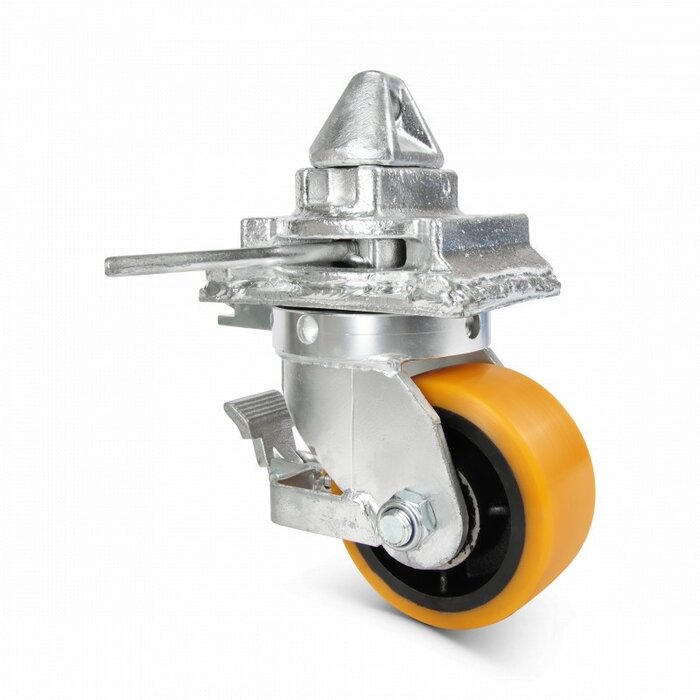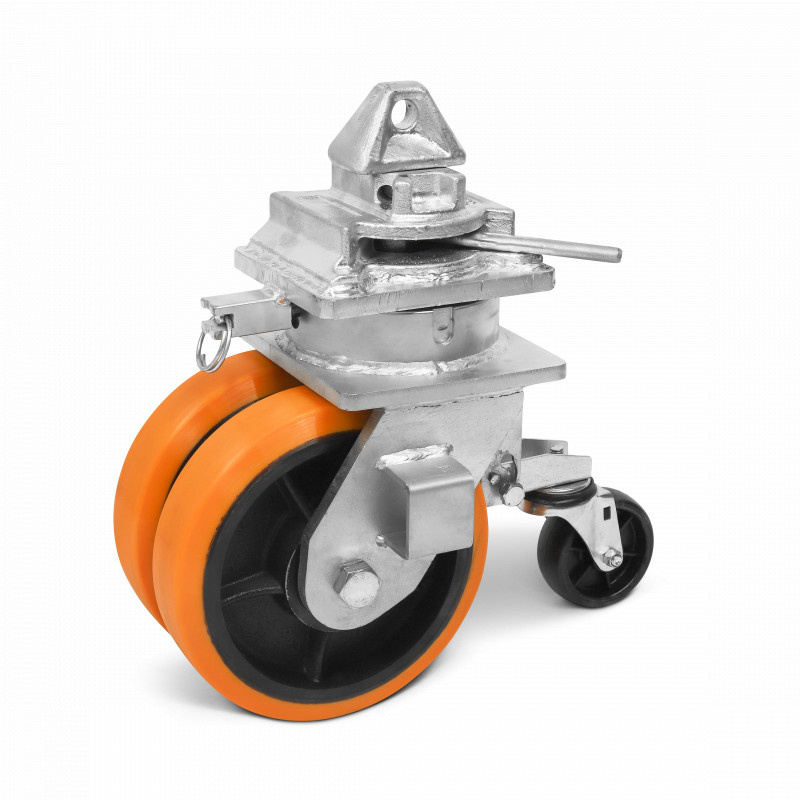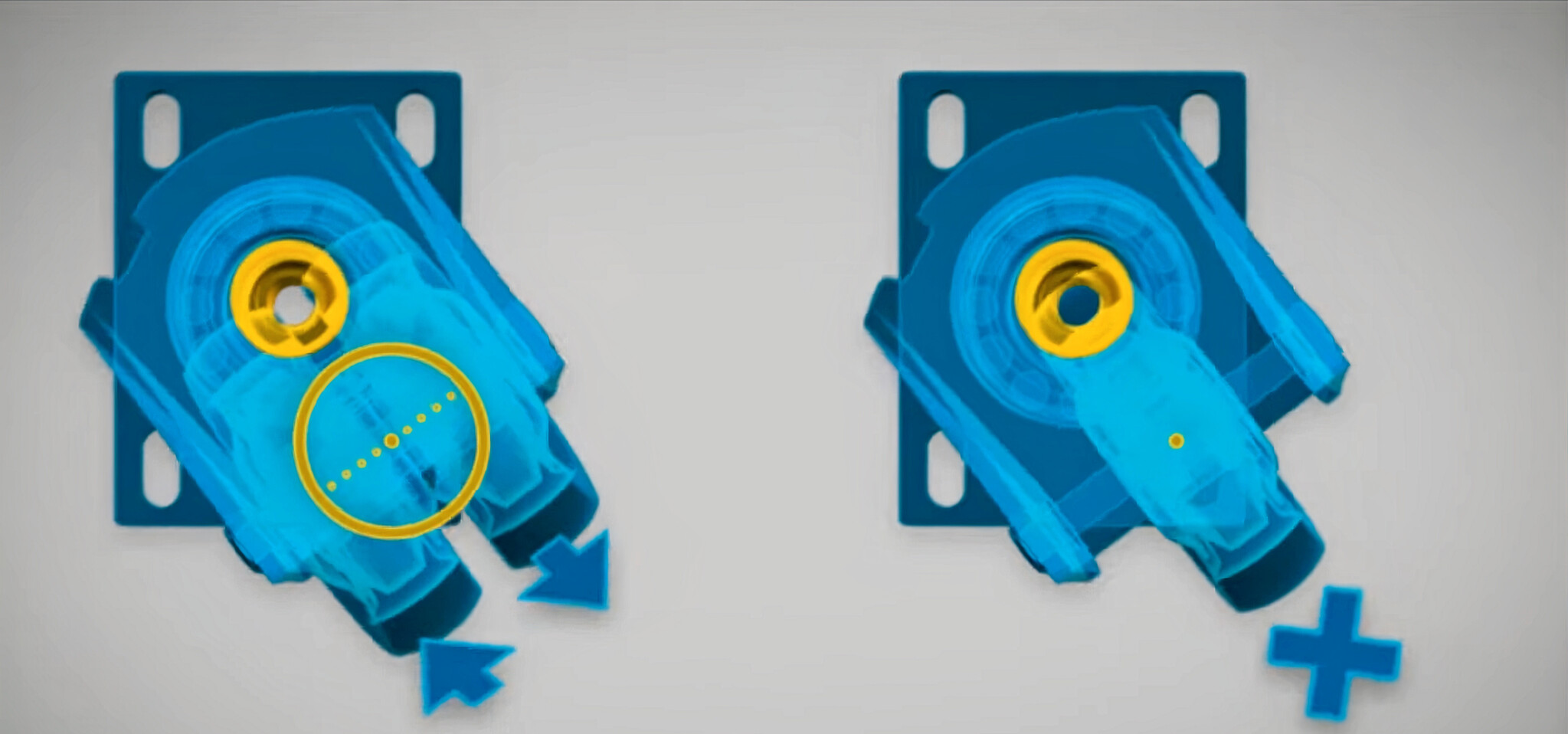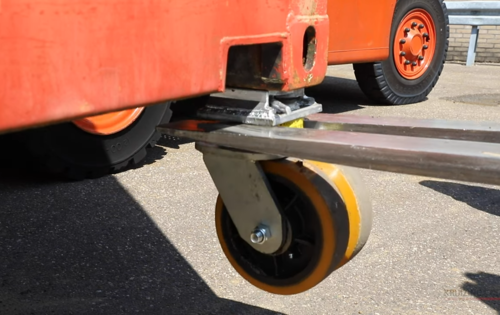
Table of contents:
Applications of Sea Container Wheels
1. How does the Twistlock Mechanism work?
2. How are Container Whells mounted?
3. What surfaces are the Container Wheels suitable for?
4. Choosing the right loading capacity
Container Wheel properties
Accessories Container Wheels
What are Container Wheels?
Container wheels, also known as shipping container wheels, are double heavy-duty wheels with a twistlock as the fastening mechanism. This system is specially designed to move shipping containers, liquid tanks or applications with a shipping container angle. Container wheels allow containers to be moved quickly and safely without a crane or truck. This allows goods to be transported effortlessly from location A to B. The mobility solution allows many companies to reduce logistics costs or store goods more efficiently. The ISO container wheels are available as standard with a polyurethane tread, universal ISO twistlock and double wheels. This ensures that the wheels have a light roll combined with a high load capacity. Sea container wheels are an invisible but crucial part of the logistics chain or warehouse technology. They contribute to the smooth and efficient flow of goods, allowing companies to operate more efficiently. The twistlock wheels can, in most cases, be moved with 1 or 2 people.
Applications of Sea Container Casters
Sea container wheels are not only used for moving sea containers over short distances, but also find their application in warehouses, chalets, construction environments and heavy engineering.
Sea Container casters for shipping
In the maritime sector, shipping container wheels play an essential role in efficiently moving goods from A to B. Whether in shipping terminals or distribution centers, these wheels offer mobility and flexibility. They ensure the smooth movement of heavy loads, greatly simplifying the loading and unloading of containers.
Applications in de construction industry
In the construction industry, container wheels are used for various purposes. From transporting building materials at the construction site to moving precast elements, these wheels provide stability and maneuverability for shipping containers, ISO tanks as well as platforms with ISO corners. This allows materials to be moved or stored more efficiently, resulting in space & time savings.
Industrial sectors
In addition to the shipping and construction sectors, shipping container wheels also find their way into various industrial applications. They are used in factories and production environments to move or store heavy machinery or bulk goods, for example. The flexibility and carrying capacity of these wheels make them ideal for intensive industrial use, contributing to a smooth workflow and optimal production efficiency.
Factors to consider:
A well-chosen shipping container wheel is crucial for efficient transportation and storage. It is important to choose the right wheel for your situation. Using and purchasing shipping container wheels correctly requires some prior knowledge about the twistlock mechanism, suitable substrates, mounting procedures and the wheel's load capacity.
1. How does the Twistlock Mechanism work?
The twistlock mechanism is the system used to attach the shipping container to the caster system. The twistlock is a standardized part that clamps at an ISO 1161 angle. The upper part of a twistlock can be rotated by 90 degrees by the lever, which locks the twistlock securely at an ISO 1161 angle. The twistlocks make connecting and disconnecting container wheels easy under various containers. The standardized dimensions allow the wheels to be used under other containers.
2. How are the Container Wheels assembled?

Smooth and safe movement of shipping containers is essential in many industries. Moving these containers correctly requires not only the right equipment, but also a thorough knowledge of safety procedures. This article discusses the crucial steps to ensure that container movement goes smoothly and without incident. Specifically, we look at the importance of level ground, proper equipment and proper attachment of shipping container wheels.
- A Flat Surface
Before starting to move a shipping container, it is very important to carefully inspect the surface. The surface should not only be flat, but also free of obstacles. Uneven ground can cause problems during the moving process. It is advisable to smooth out any unevenness before starting to move the container.
- Lifting the Container
Using the right tools is critical when moving heavy shipping containers. Several options are available, including a container jack, a forklift or a crane. Choosing the most appropriate tool depends on the specific situation and the weight of the container. It is essential to use the right equipment to avoid accidents.
- Attachement of Twist-lock System
When moving shipping containers, it is very important that the container wheels are attached correctly. This is usually done from below, placing the container wheel in conjunction with drag wheel under the corner of the container. Then the twist-lock system can be locked into the corner casting for a secure attachment. Our high-quality shipping container wheels fit perfectly into any ISO 1161 corner casting, making them suitable for various container models.
- Safety regulations
It is critical to remain vigilant throughout the process. In some cases, the load of a container may be unevenly distributed on the wheels due to a skewed load, uneven terrain or presence of obstacles. In such situations, it is necessary to take extra care. We recommend evenly distributing and checking the container's load before moving it. If in doubt about the load capacity, contact us to minimize possible risks.
3. For wich surfaces are Container Wheels suitable for?
Sea container wheels are made to carry heavy loads and move smoothly even on different types of surfaces. Choosing the right container wheel depends on several factors, one of the most important of which is the surface.
- Hard surfaces: Concrete, Asphalt, Factory floors and Warehouses
Sea container wheels with a polyurethane tread are suitable for hard surfaces such as concrete and asphalt. The polyurethane tire has light damping and low coefficient of friction combined with high load capacity. This ensures that container wheels can be easily moved on rough surfaces. For internal transport on factory floors and warehouses, shipping container wheels with polyurethane tires are ideal. These tires do not leave streaks and protect floors from damage. In addition, they offer low rolling and collision resistance.
- Soft surfaces: Grass, Sand and Earth
With soft surfaces such as grass fields, sand and earth, it is crucial to choose shipping container wheels with large wide pneumatic tires. Wide tires increase the surface area of contact with the ground, evenly distributing the weight of the load. This prevents the wheels from sinking into the soft soil, allowing the transport to continue without problems. These features ensure a smooth ride even on uneven roads. The pneumatic tires help minimize vibration and shock, keeping the container load stable even on rough terrains. These shipping container wheels can be supplied upon request.
4. The load capacity
The load capacity of shipping container wheels determines how much weight they can support without being overloaded. It is vital to choose the right load capacity to prevent the wheels from wearing out, damaging or even breaking. Failure to adhere to the proper load capacity can lead to accidents, damage and downtime for businesses.
Determining the required load capacity of shipping container wheels requires simple calculations. One must take into account the total weight of the load + its own weight which is then divided by three. The calculation goes as follows:
- Divide the total weight of the application by 3 = The desired load capacity per wheel
Example:
An empty 40-foot container weighs 4 kilotons and must be able to carry 5 kilotons.
Loading capacity = (4000 + 5000) / 3 = 3000 kg per wheel
The calculated load capacity is based under rolling conditions with a speed of 4 k/m and a safety margin for an uneven load or surface. If higher speeds or uneven loads are used it is advisable to contact us for appropriate advice.
Three types of Sea Container Wheels


1800 kg: This type of shipping container wheels has a single wheel. They are suitable for lighter loads and are often used for a 20-foot container used for internal transport or to be moved.
3000 kg: These shipping container wheels are ideal for medium to heavy loads of 9000 kg. They are often used for 40-foot shipping containers.
4500 kg: The heavy duty shipping container wheels are designed to carry the heaviest loads, up to 13500 kg. They are used for special loads and situations where extreme carrying capacity is required
Container wheel features
The container wheels are equipped with the following options that improve user-friendliness in terms of assembly, safety, rolling resistance and manoeuvrability.

- Double wheels
Wheels with dual construction offer improved maneuverability, this is especially useful when maneuvering in tight spaces. The dual wheel system ensures that the center of pivot is centered between the two wheels, this distributes the load evenly between two wheels. This creates a contrary roll of both wheels when slewing, reducing slewing rotation compared to a single wheel. In addition, dual wheels offer lower rolling resistance combined with maintaining a substantial load capacity.
- Brake mechanism
The container wheels are also available with a braking system, this system only locks the wheel preventing the container from rolling on sloping surfaces or wind. However, it is not essential to choose braked wheels, often, depending on the high load capacity, some force is required to move the application.
- Directional lock
The turntable possesses a 4 directional lock that can be locked every 90 degrees. This allows the user to block the rotation of the turntable in a certain direction on both the front and side and turn it into a ‘'fixed-wheel’'. This ensures that maneuverability can be changed in a flexible manner. The container can be driven in the following ways:
Option 1: No caster lock with a directional lock. this creates the shortest turning radius with maximum maneuverability, often used environments where space is limited.
Option 2: Two caster wheels fixed with a directional lock. This creates the same effect as a transport cart with two fixed casters and two swivel casters. The maneuverability works well for long and straight distances.
- Drag wheel
At the rear of the caster system is a collapsible tow/nose wheel mounted. This allows the caster to be driven upright on three wheels in a triangular arrangement under an ISO Twistlock. This improves usability while clamping an ISO Twistlock under a heavy container, but also reduces the risk of workplace accidents.
Accessories Container Wheels
In addition to the caster system itself, several accessories are available to enhance functionality and safety.

- Pull bar
The tow bar, also known as a tow bar, is an indispensable tool for the efficient transport of wheeled containers. This metal connecting piece, attached to corner pieces and to a forklift or tractor, makes it effortless and efficient to move containers easily over longer distances such as at loading docks, ports and other industrial locations. The tie rod can be easily locked in the corners with a swivel system, in addition, the rod has a coupling point at the end that allows it to be coupled with a vehicle. Often the tie rods are purchased in situations where the shipping container is frequently used to move goods, with the tie rod the logistics are optimized and time is saved.
- Pushbar
A push bar, or push bar is made to safely push a container wheel under a shipping container. A push bar is coupled into two square holes located on the side of the swivel fork. The
push bars allow a container wheel to be easily wheeled and moved under a heavy shipping container. By using the proper push bar, the operator can steer smoothly and keep distance from the container. The use of push rods significantly reduces the risk of accidents while placing container wheels.
- Anti Theft Lock
An anti-theft lock, also known as a wheel clamp for container wheels, acts as an additional layer of security. Designed to completely block containers from any roll, it protects against unauthorized access and theft. The wheel clamp attaches securely to the spokes of the caster wheels, making any kind of roll impossible without the unique insert key. To secure an anti-theft lock, the user places the lock between the spokes in the width of the wheel. The clamp is then securely locked using the lock. An anti-theft lock is often purchased when a container is on public property.
Personalized advice or customization?
Interwheel offers a standard range of container casters that are versatile for shipping containers, ISO tanks and corner castings. However, we understand that our container wheels may not be sufficient for your situation. For this we offer custom casters tailored to the desired specifications and situation. If you would like more information about this, please feel free to contact us at [email protected], +31 (0)26 383 5988 or live chat.

